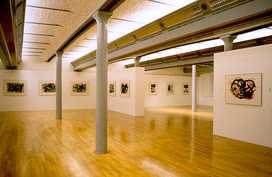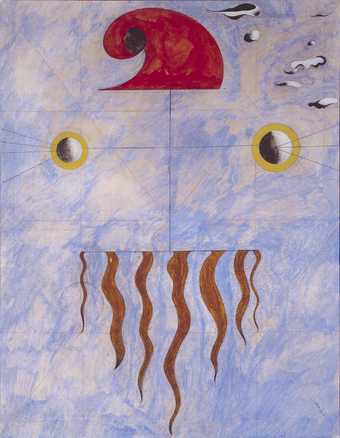
Miro Tate Liverpool Installation Shot
Miró was already 36 years old and well known as a painter when he started making prints. It became a vital part of his art and he experimented endlessly with a broad variety of techniques, from the soft lines of the drypoint Daphnis & Chloe 1933 to the explosive boldness of Barbaric Dance 1963. Throughout his long career – Miró continued to make work right up until his death in 1983 – he was constantly looking for new ways of working. He produced an enormous amount of work in a range of different media, including ceramics and tapestry. The prints in this exhibition illustrate both his growing confidence as a printmaker and the development which took place in his work as a whole, from the finely drawn, strange figures to the gestural, simplified forms of the later works.
The first prints which Miró made were created to accompany the work of the poet, Tristan Tzara, in his book L'arbre des voyageurs (The Travellers' Tree). Miró often collaborated with poets and always hoped that his work would be 'like a poem set to music by a painter'. It is significant that the titles of his works were often arrived at simply by what the final image suggested to him after he had worked on it and are often quite poetic in themselves.
The mind which plunges into Surrealism relives with glowing excitement the best part of its childhood
Andre Breton in The First Manifesto of Surrealism 1924
Along with Max Ernst and Andre Masson, Miró had been one of the first artists to join the Surrealist group in Paris in the 1920s. The impact of that movement's ideas about the importance of dream images and the 'disinterested play of thought' remained with him throughout his life. While he was at one point described by the leader of the group, the writer Andre Breton, as 'the most Surrealist of us all', Miró also disagreed in many ways with Breton's political ideas and what he expected of painting.
He did contribute to the development of Surrealist 'automatism' (writing, drawing and painting directly from the unconscious), making extensive use of found images, fragments of words or earlier sketches as the starting point for a work. He always carried a small spiral-bound notebook with him in which he would fix any form that came to mind. These sketches, cut-out images and bits of text would be used to establish a composition, which he would keep by him while painting, or making a print, in order not to lose contact with the original inspiration. Allowing the marks he made to dictate both the formation of an image and the direction for the next work, this process was effectively his own kind of automatism, feeding off everything and anything in his surrounding environment.
When he began making the prints in this exhibition, Miró's ties with Breton and Surrealism were already strained. He objected to Breton's demands as to what painting should be, but continued with his own, individual use of the movement's ideas about fantasy and dreams.
The two types of print-making Miró used were lithography and illtaglio (where the drawing is etched or engraved onto a metal plate).In lithography, the ink lies on the surface of the stone or plate, whereas in intaglio processes, ink is forced into engraved lines. To print, paper is placed over the stone or plate and passed through a press.
Hard-Ground Etching
The metal plate is heated and covered evenly with a layer of wax, which becomes firm to the touch when it cools. The drawing is made through the wax with etching tools. Once the drawing is complete, the plate is immersed in acid which bites into the exposed lines. The length of time the plate remains in the acid affects the depth of the lines. Deeper lines hold more ink and are therefore much darker when printed.
The process can be repeated several times with each plate. For example, in the Portrait of Miró 1938 series, some areas have been covered or 'stoppedout' after the first print and others have been etched several times, making the lines much stronger and darker.
Soft-Ground Etching
In soft-ground etching, the wax used does not become firm after it has been applied to the plate and marks can easily be made on it with different materials or even fingers. It can also be drawn through with pencil, making a much softer line. As with the above, the plate is then immersed in acid, inked and printed.
It is used to make areas of texture, as in The Hand 1953, where an imprint of Miró's own hand can be seen.
Drypoint
A drawing is made directly onto a metal plate with a burin (like a needle). When the drawing is finished and the first print of it is ready to be made, the plate is inked and then wiped clean - leaving ink - only in the drawn lines. Dampened paper is placed over the plate and it is then ready for the press.
Drypoint produces a soft, velvety line as in Daphnis and Chloe 1933.

